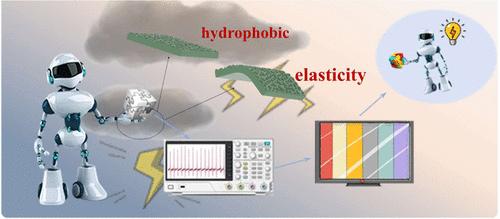Our official English website, www.x-mol.net, welcomes your
feedback! (Note: you will need to create a separate account there.)
Hydrophobic and Elastic Structural Triboelectric Materials Enabled by Template Method toward Real-Time Material Recognition
ACS Sensors ( IF 8.2 ) Pub Date : 2024-11-07 , DOI: 10.1021/acssensors.4c01799 Junjun Huang, Yuting Zong, Kunhong Hu, Wenlong Chen, Yue Liu, Zhenming Chen, Honglin Li, Chengmei Gui
ACS Sensors ( IF 8.2 ) Pub Date : 2024-11-07 , DOI: 10.1021/acssensors.4c01799 Junjun Huang, Yuting Zong, Kunhong Hu, Wenlong Chen, Yue Liu, Zhenming Chen, Honglin Li, Chengmei Gui

|
Since each material has a unique ability to lose or obtain electrons, specific triboelectric signals are produced when triboelectric materials are in contact with different objects. Triboelectric nanogenerator (TENG) devices show great potential for use as tactile sensors; nevertheless, analyzing the structure–function relationship of functionalized triboelectric sensing interfaces under environmental conditions and improving the sensing stability and accuracy through the design of hydrophobic structure on the triboelectric material surface remain major challenges in the development of intelligent sensing networks. Compared with the traditional rigid micronanostructure, the elastic micronanostructure strategy is applied to achieve both hydrophobicity and stability of triboelectric materials based on the template method in this work. The corresponding surface roughness and contact angle are 89.9 nm and 117.9°, respectively. As expected, the output voltage and charge density are enhanced by almost 65.8 and 33.4%, respectively, with the establishment of an elastic micronanostructure on the triboelectric material surface. More importantly, the triboelectric signal waveforms also present acceptable durability for subsequent recognition after immersion in water or ethanol for 12 days and metal impact for 12 000 cycles. Hence, combined with deep machine learning and triboelectric effect, a material perception system integrated with a moisture-resistant TENG-based sensor after fatigue testing, data processing, and display modules is also developed for real-time monitoring with approximately 100% (mask), 76% (plank), 93% (plastic), and 89% (rubber) identification accuracies in the natural environment. Finally, the proposed hydrophobic and elastic triboelectric materials show broad potential for application in the field of human–computer interaction.
中文翻译:

通过模板方法实现疏水和弹性结构摩擦电子材料实现实时材料识别
由于每种材料都有独特的失去或获得电子的能力,因此当摩擦电材料与不同的物体接触时,会产生特定的摩擦电信号。摩擦纳米发电机 (TENG) 设备显示出用作触觉传感器的巨大潜力;然而,分析环境条件下功能化摩擦电传感接口的结构-功能关系,并通过摩擦电材料表面疏水结构的设计来提高传感稳定性和精度仍然是智能传感网络发展的主要挑战。与传统的刚性微纳结构相比,本工作基于模板方法应用弹性微纳米结构策略实现了摩擦电材料的疏水性和稳定性。相应的表面粗糙度和接触角分别为 89.9 nm 和 117.9°。正如预期的那样,随着摩擦电材料表面弹性微纳米结构的建立,输出电压和电荷密度分别提高了近 65.8% 和 33.4%。更重要的是,摩擦电信号波形在浸入水或乙醇 12 天和金属冲击 12 000 次循环后,也表现出可接受的耐久性,便于后续识别。因此,结合深度机器学习和摩擦电效应,在疲劳测试、数据处理和显示模块后,还开发了与防潮 TENG 传感器集成的材料感知系统,用于实时监控,在自然环境中具有大约 100%(掩模)、76%(木板)、93%(塑料)和 89%(橡胶)的识别精度。 最后,所提出的疏水和弹性摩擦电材料在人机交互领域显示出广泛的应用潜力。
更新日期:2024-11-09
中文翻译:

通过模板方法实现疏水和弹性结构摩擦电子材料实现实时材料识别
由于每种材料都有独特的失去或获得电子的能力,因此当摩擦电材料与不同的物体接触时,会产生特定的摩擦电信号。摩擦纳米发电机 (TENG) 设备显示出用作触觉传感器的巨大潜力;然而,分析环境条件下功能化摩擦电传感接口的结构-功能关系,并通过摩擦电材料表面疏水结构的设计来提高传感稳定性和精度仍然是智能传感网络发展的主要挑战。与传统的刚性微纳结构相比,本工作基于模板方法应用弹性微纳米结构策略实现了摩擦电材料的疏水性和稳定性。相应的表面粗糙度和接触角分别为 89.9 nm 和 117.9°。正如预期的那样,随着摩擦电材料表面弹性微纳米结构的建立,输出电压和电荷密度分别提高了近 65.8% 和 33.4%。更重要的是,摩擦电信号波形在浸入水或乙醇 12 天和金属冲击 12 000 次循环后,也表现出可接受的耐久性,便于后续识别。因此,结合深度机器学习和摩擦电效应,在疲劳测试、数据处理和显示模块后,还开发了与防潮 TENG 传感器集成的材料感知系统,用于实时监控,在自然环境中具有大约 100%(掩模)、76%(木板)、93%(塑料)和 89%(橡胶)的识别精度。 最后,所提出的疏水和弹性摩擦电材料在人机交互领域显示出广泛的应用潜力。


















































 京公网安备 11010802027423号
京公网安备 11010802027423号